Walking mindfully for just ten minutes a day can melt away your anxiety through proven techniques. You'll start by syncing your breath with each step, choosing a peaceful environment like a park or nature trail. Set an easy pace that feels natural, and focus on the sensations beneath your feet. Notice nature's intricate details – from leaf patterns to filtered sunlight. Release tension through your shoulders while maintaining good posture, and practice gratitude for the simple gifts around you. Create a personal walking ritual, and track your progress to build consistency. These transformative steps will guide you toward a calmer, more centered state of mind.
Start With Mindful Breathing

Everyone can benefit from proper breathing before starting a worry-relieving walk. Begin by standing tall with your feet shoulder-width apart and your arms relaxed at your sides. Take three deep breaths, inhaling through your nose for four counts and exhaling through your mouth for six counts. You'll notice your shoulders dropping and tension melting away with each breath.
As you prepare to walk, maintain this conscious breathing pattern. Focus on the sensation of air filling your lungs and the gentle release as you exhale. If your mind wanders to worrisome thoughts, gently redirect your attention to your breath. This mindful breathing technique helps activate your parasympathetic nervous system, reducing stress hormones and preparing your body for a calming walk.
Remember to keep your breathing natural and rhythmic as you shift into walking. Don't force it or create additional tension by trying too hard. Your breath should flow easily, creating a foundation of calmness that you'll carry throughout your walk.
This initial breathing practice sets the tone for a more therapeutic and anxiety-reducing experience.
Choose Your Walking Environment
Three key factors make your walking environment vital for anxiety relief: noise level, natural elements, and personal safety.
You'll want to select a route where traffic sounds and urban chaos won't overwhelm your senses. Parks, nature trails, and quiet residential streets typically offer the most calming atmospheres.
Natural elements play an essential role in reducing stress. Look for paths with trees, gardens, or water features. Research shows that exposure to greenery lowers cortisol levels and blood pressure.
If you can't access hiking trails, seek out tree-lined neighborhoods or community gardens.
Your safety should always come first. Choose well-lit areas if you're walking early morning or evening, and stick to populated routes where you feel secure.
You don't want safety concerns competing with your relaxation goals. Consider varying your route based on the time of day – a busy park might work better during daylight hours, while a well-lit suburban street could be ideal for evening walks.
If possible, scout your potential walking routes in advance. This preparation helps you focus on the therapeutic aspects of your walk rather than worrying about navigation or unexpected obstacles.
Set a Comfortable Pace
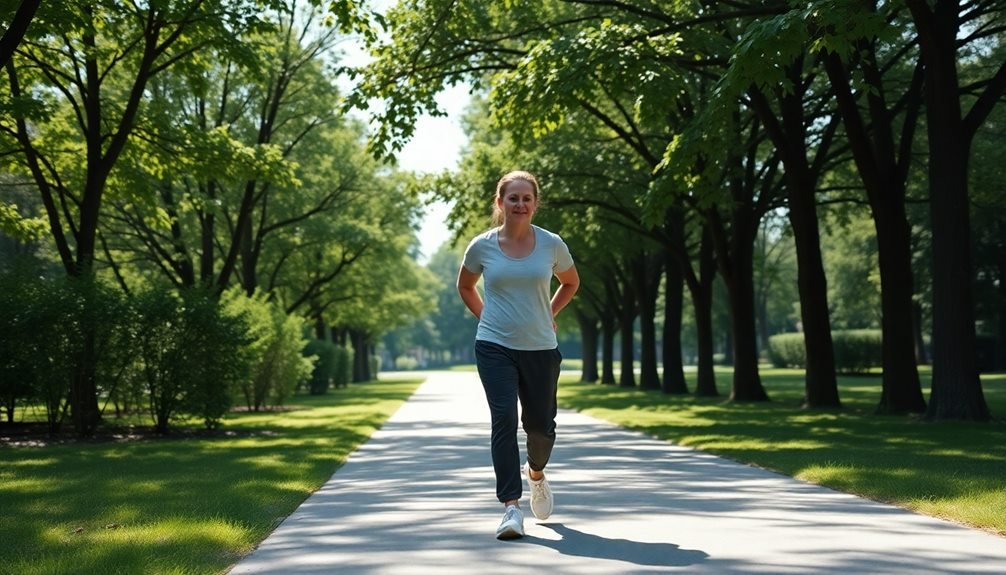
When you begin your worry-relieving walk, start at an easy pace that lets you ease into the rhythm of movement.
You'll naturally find yourself picking up speed as your muscles warm up, but there's no need to push beyond what feels right for your body.
Sync your breathing with your footsteps, creating a natural walking meditation that helps quiet your mind.
Start Slow, Build Momentum
Starting your walk at a gentle pace sets the foundation for a sustainable anxiety-reducing routine.
Begin with a 5-minute stroll at a speed that allows you to maintain a normal conversation. This initial phase helps warm up your muscles and gradually elevates your heart rate without overwhelming your body or mind.
As you feel more comfortable, gradually increase your walking duration by adding 2-3 minutes each week. You'll notice that your body naturally wants to pick up the pace as your fitness improves. Listen to these physical cues, but don't rush the progression. If you're dealing with anxiety, rapid changes can trigger stress responses.
Once you've established a consistent 20-minute walking routine, you can experiment with your pace.
Try walking briskly for 2-minute intervals, followed by 1 minute at your regular speed. These intervals help release endorphins more effectively while maintaining the meditative benefits of your walk.
Listen to Your Body
Throughout your walk, your body sends clear signals about the right pace for your anxiety-reducing journey. When you're aiming to reduce stress and anxiety, it's essential to maintain a pace that feels natural and sustainable, rather than pushing yourself too hard.
You'll know you're at the right intensity when you can still carry on a conversation without feeling winded.
- Monitor your breathing: If you're gasping for air or can't speak in full sentences, slow down. Your breath should be steady and controlled, allowing you to focus on the calming aspects of your walk.
- Check your muscles: Pay attention to any tension or discomfort. Your shoulders should be relaxed, and your steps should feel fluid and natural. If you're experiencing strain, adjust your pace accordingly.
- Track your heart rate: While you don't need precise measurements, you should feel your heart beating slightly faster than usual without pounding. This moderate intensity helps trigger the release of stress-reducing endorphins.
If you notice signs of fatigue or discomfort, don't hesitate to slow down or take a brief rest. Remember, this walk is about relieving anxiety, not creating more stress.
Match Breath to Steps
Once you've found your comfortable walking pace, combining it with deliberate breathing creates a powerful rhythm for anxiety relief. Start by inhaling for two steps and exhaling for two steps, gradually finding your natural breath-to-step ratio. You'll notice how this synchronized movement helps quiet racing thoughts and brings your focus to the present moment.
As you continue walking, you might discover that a 3:3 or 4:4 breathing pattern feels more natural. Listen to what works for your body and adjust accordingly. If you're walking uphill, you may need shorter breath cycles, while downhill stretches might allow for longer ones.
Don't force yourself to maintain a specific pattern if it feels uncomfortable.
When your mind wanders, gently redirect your attention to counting your steps and breaths. This simple technique becomes an active meditation, helping you release tension with each exhale.
You'll find that matching your breath to your steps not only enhances your walking practice but also teaches you a portable stress-management tool you can use anywhere, anytime.
Focus on Each Step
As you take each step during your walk, direct your attention to the physical sensations beneath your feet. Feel how your heel makes initial contact with the ground, followed by the roll through the arch of your foot, and finally, the push-off from your toes. This simple awareness practice helps anchor your mind to the present moment, reducing anxious thoughts about the past or future.
When practicing step-focused walking, pay attention to these key elements:
- Surface texture – Notice how different terrains feel beneath your feet, from smooth pavement to uneven grass or crunchy gravel.
- Weight distribution – Observe how your body's weight shifts from one foot to the other as you move forward.
- Muscle engagement – Feel the subtle contractions in your feet, calves, and legs with each step.
If your mind wanders, that's perfectly normal. Simply acknowledge the distraction and gently guide your focus back to the physical sensations of walking.
This mindful walking technique not only calms your nervous system but also strengthens your ability to maintain present-moment awareness in other areas of your life.
Notice Nature's Details
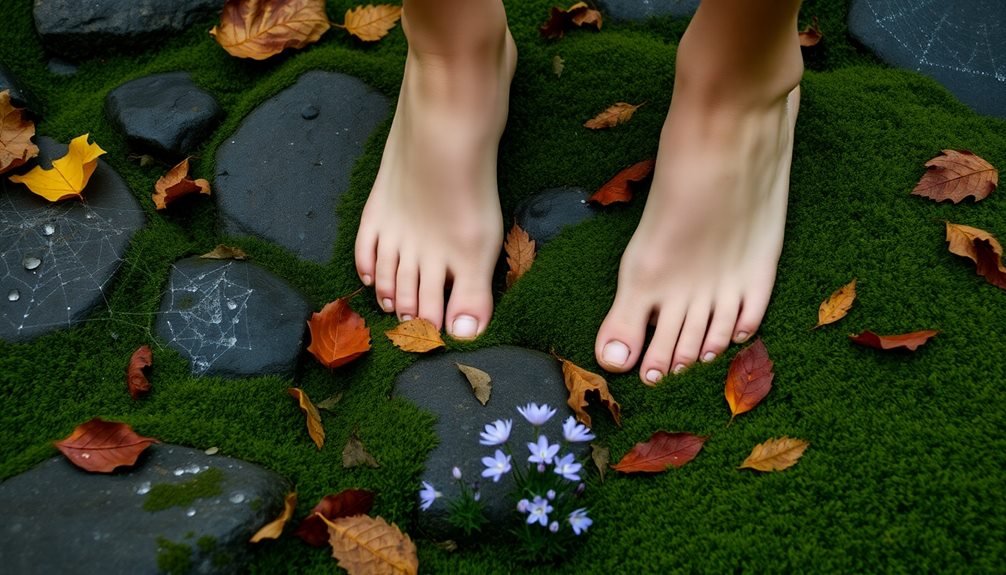
Nature's wonders provide endless opportunities to calm your mind during your walk. As you stroll, challenge yourself to notice the intricate details surrounding you. Look for the delicate veins running through fallen leaves, observe how sunlight filters through tree branches, or watch the way clouds shift and change shape overhead.
You'll discover that focusing on nature's fine points draws your attention away from worrying thoughts. Pay attention to the subtle variations in bark textures on different trees, spot the tiny wildflowers pushing through sidewalk cracks, or follow the path of a busy ant carrying its load. Listen for the distinct songs of various birds, the rustle of leaves in the breeze, or the distant sound of flowing water.
Each season offers unique details to observe. In spring, watch for new buds forming; in summer, study the patterns of butterfly wings; in autumn, collect differently colored leaves; and in winter, examine frost patterns or snowflake shapes.
Listen to Surrounding Sounds
Beyond the visual details of your environment, the soundscape of your walk offers another powerful way to quiet anxious thoughts. As you move through your route, tune in to the symphony of sounds surrounding you. You'll discover that focusing on these audio elements helps anchor your mind in the present moment, drawing attention away from worrying thoughts.
When you're ready to explore the soundscape, try these specific listening techniques:
- Start with the most distant sounds you can hear – perhaps airplanes overhead, church bells, or far-off traffic – then gradually work your way closer to nearby sounds like rustling leaves or conversations.
- Identify natural versus human-made sounds, counting how many of each you can detect within a 30-second window.
- Focus on the rhythm of your own footsteps and breathing, using them as a steady baseline while you layer other environmental sounds on top.
You'll notice that active listening requires mental engagement, making it difficult to simultaneously hold onto stress. Let the sounds wash over you, creating a natural meditation that transforms your walk into a mindful journey.
Release Tension While Moving

As you move forward with each step, sync your breathing to create a natural walking rhythm that helps dissolve stress.
You'll want to roll your shoulders back periodically to release built-up tension in your upper body, letting gravity pull them into a relaxed position.
Keep your awareness on any muscles you tend to tighten while walking – particularly in your neck, jaw, and legs – and consciously let them soften as you continue your journey.
Breathe Through Each Step
Tension melts away when you synchronize your breathing with each footstep. As you walk, focus on creating a natural rhythm between your breath and movement. You'll find that matching your inhales and exhales to your stride helps clear your mind while energizing your body.
Try these synchronized breathing patterns during your walk:
- Four-count walking breath: Inhale for four steps, then exhale for four steps. This pattern helps regulate your heart rate and promotes mental clarity while maintaining a steady pace.
- Step-by-step awareness: Focus on feeling your heel-to-toe movement as you inhale on one step and exhale on the next. This method grounds you in the present moment and enhances your mind-body connection.
- Recovery breathing: Take three quick steps while inhaling deeply, then exhale slowly over the next five steps. This technique helps release accumulated stress and resets your nervous system.
Remember to keep your shoulders relaxed and your chest open as you practice these breathing patterns.
Don't force the rhythm – let it develop naturally as you move. You'll notice your thoughts becoming clearer and your muscles relaxing with each mindful step.
Roll Those Shoulders Back
Your shoulders carry the weight of daily stress, often becoming tight and hunched without you noticing. As you walk, consciously focus on releasing this built-up tension by practicing shoulder rolls while maintaining your natural stride.
Start by dropping your shoulders away from your ears and rolling them backward in slow, deliberate circles. Make each rotation smooth and controlled, timing them with your steps if that feels comfortable. You'll feel the muscles along your upper back and neck begin to loosen with each movement.
After every few shoulder rolls, pause to check your posture. Keep your head aligned with your spine, imagine a string pulling you up from the crown of your head, and let your arms swing naturally at your sides. If you notice tension creeping back, repeat the shoulder rolls.
When you encounter uphill sections during your walk, avoid hunching forward. Instead, maintain an upright posture and use smaller shoulder circles to prevent strain.
Combine these movements with your breathing pattern: roll your shoulders back as you inhale, and relax them down as you exhale.
Unclench Your Walking Muscles
Many people unknowingly clench their muscles while walking, creating unnecessary tension throughout their body. While walking to reduce anxiety, it's crucial to periodically scan your body for areas of tightness and consciously release them. Start by focusing on common tension spots like your jaw, neck, and shoulders, then work your way down to your legs and feet.
To effectively release tension while walking, practice these key techniques:
- Take inventory of your muscles every few minutes by mentally scanning from head to toe, actively relaxing any areas that feel tight or contracted.
- Let your arms swing naturally at your sides, keeping your hands loose instead of forming fists or holding them stiffly.
- Focus on your feet, ensuring they're not gripping the ground – allow them to roll smoothly from heel to toe with each step.
Remember that your walking posture directly affects your stress levels. When you notice tension creeping back in, simply acknowledge it and gently release it.
This mindful approach to walking helps transform a simple stroll into a powerful anxiety-reducing exercise, allowing your body to move more efficiently and naturally.
Practice Gratitude During Walks
Walking through nature offers a perfect opportunity to cultivate gratitude and shift your mindset from stress to appreciation. As you walk, focus on the simple gifts around you – the warmth of sunlight on your skin, the gentle rustle of leaves, or the rhythmic sound of your footsteps on the path.
Start your gratitude practice by noticing five specific things you're thankful for during your walk. You'll find it's easier to spot positives when you're moving through changing scenery. Notice the fresh air filling your lungs, the strength in your legs, or the freedom to explore your surroundings.
Don't rush this process – let each grateful thought settle in your mind.
Try expressing your gratitude verbally or mentally as you walk. You might say, "I'm grateful for this moment of peace" or "Thank you for this beautiful day."
If you're walking regularly, consider keeping a gratitude journal and jotting down your observations after each walk. This practice helps cement positive memories and creates a valuable record of life's daily gifts, transforming your walks into meaningful moments of reflection and appreciation.
Create Walking Rituals

Transform your daily walk into a sacred practice by treating it as protected time for self-care and reflection.
You'll get more from your walking practice when you set a clear intention before you begin, whether it's to release stress, solve a problem, or simply clear your mind.
Setting this mindful foundation helps you approach each walk with purpose, making it more than just physical exercise – it becomes your personal ritual for mental well-being.
Make It Sacred Time
By establishing mindful rituals around your daily walks, you'll create a sacred space that separates worry time from healing time.
Think of your walking time as a moving meditation, where each step brings you closer to mental clarity and emotional balance. You're not just exercising your body; you're giving your mind permission to process and release what's weighing it down.
Transform your walk into a sacred practice by incorporating these intentional elements:
- Begin each walk with a brief moment of stillness. Stand quietly, take three deep breaths, and set an intention for your journey – whether it's finding solutions, letting go of stress, or simply being present.
- Choose a personal walking mantra that resonates with your current needs. Repeat it silently as you walk, allowing it to sync with your footsteps and breath. It could be as simple as "Peace with each step" or "I release and renew."
- End your walk with a gratitude pause. Before returning to your daily routine, acknowledge three things you're thankful for, cementing the positive energy you've cultivated during your sacred walking time.
Set Your Walking Intention
Setting a clear intention before you step out the door can transform an ordinary walk into a purposeful journey of self-discovery. Whether you're seeking stress relief, mental clarity, or emotional balance, declaring your walk's purpose helps focus your mind and amplify its benefits.
Begin by taking three deep breaths and silently stating your intention. You might choose "I'm walking to release anxiety" or "This walk will help me find solutions." Let this intention guide your pace, breathing, and thought patterns throughout your journey.
If you're processing difficult emotions, you can decide to "leave them on the path" as you walk, visualizing each step as a release.
Create a simple ritual that marks the change into your intentional walk. Touch a specific tree, pause at your garden gate, or say a meaningful phrase. These small acts signal to your brain that you're entering a different mental space.
As you walk, periodically reconnect with your initial intention, especially when your mind wanders. You'll find that having a clear purpose makes your walk more meaningful and its benefits more profound.
Track Your Progress
Keeping tabs on your walking journey serves as powerful motivation to maintain your anxiety-reducing routine. You'll find that measuring your progress helps reinforce positive habits while giving you tangible evidence of your commitment to mental wellness.
Whether you use a fitness tracker, smartphone app, or simple notebook, recording your walks creates accountability and helps you identify patterns in your mood improvements.
- Record essential metrics like distance covered, duration, and your anxiety levels before and after each walk. You'll start noticing correlations between longer walks and better mental states, helping you optimize your routine.
- Take weekly progress photos along your favorite walking routes. You'll appreciate seeing how your posture improves and how your facial expressions become more relaxed over time.
- Log your energy levels and sleep quality in relation to your walks. You'll discover that consistent walking often leads to better sleep patterns and increased daytime liveliness.
Don't forget to celebrate your milestones, whether it's reaching a certain number of consecutive days walking or noticing that you're handling stress better.
These achievements reinforce the positive impact of your walking practice on your mental health.
Frequently Asked Questions
Can Walking Meditation Be Effective in Groups or Only When Alone?
You can practice walking meditation effectively both alone and in groups. When you're with others, you'll benefit from shared energy and accountability, while solo practice lets you focus entirely on your personal mindful experience.
What Shoes Are Best for Mindful Walking Practices?
You'll want lightweight, comfortable shoes with good cushioning and flexibility. Don't overthink it – any shoes that let you focus on walking rather than discomfort will work for mindful walking practices.
How Long Should a Worry-Relief Walk Ideally Last?
You'll get the most benefit from a 20-30 minute worry-relief walk, but even 10 minutes can help. Don't push yourself too hard; listen to your body and walk until you feel mentally refreshed.
Is Indoor Walking as Beneficial as Outdoor Walking for Stress Relief?
While indoor walking can help reduce stress, you'll get more benefits walking outdoors. Natural light, fresh air, and changing scenery boost your mood and lower stress levels more effectively than indoor environments.
Should I Avoid Walking Meditation During Specific Weather Conditions?
You shouldn't walk meditate during thunderstorms, extreme heat, or icy conditions. If there's severe weather, practice indoor walking meditation instead. It's safer and still offers similar mindfulness benefits.
In Summary
You've learned powerful steps to transform an ordinary walk into a therapeutic journey. By combining mindful breathing, intentional movement, and gratitude practices, you're now equipped to make every walk count. Whether you choose a serene park or busy neighborhood street, you'll find these walking meditation techniques can ease your worries and brighten your outlook. Start small, stay consistent, and watch your daily walks become powerful stress-relieving rituals.


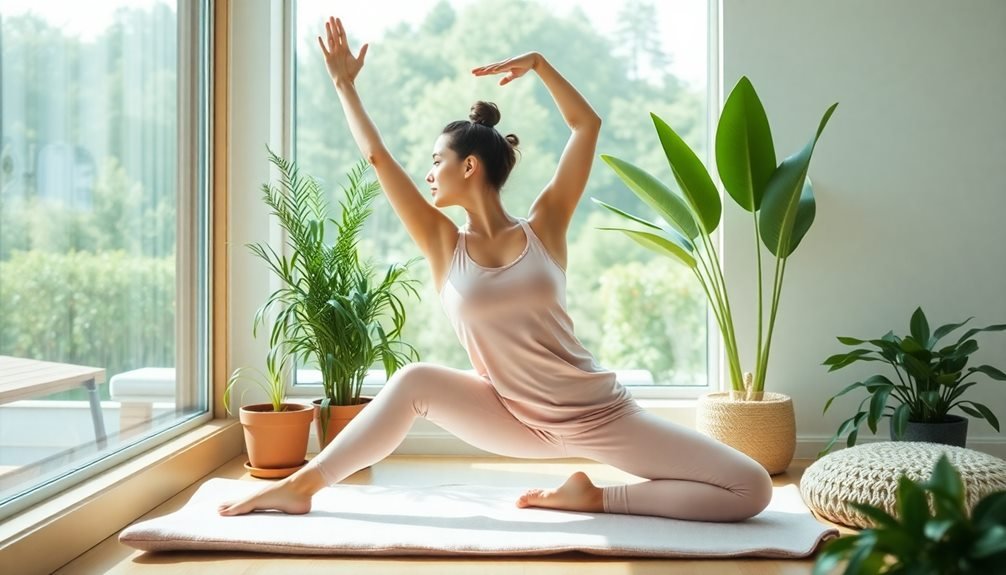
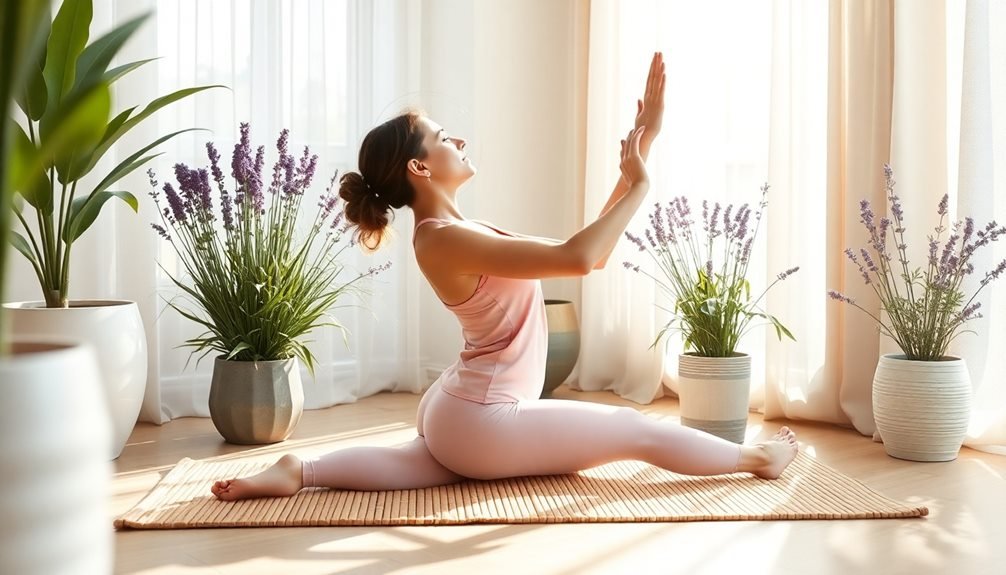
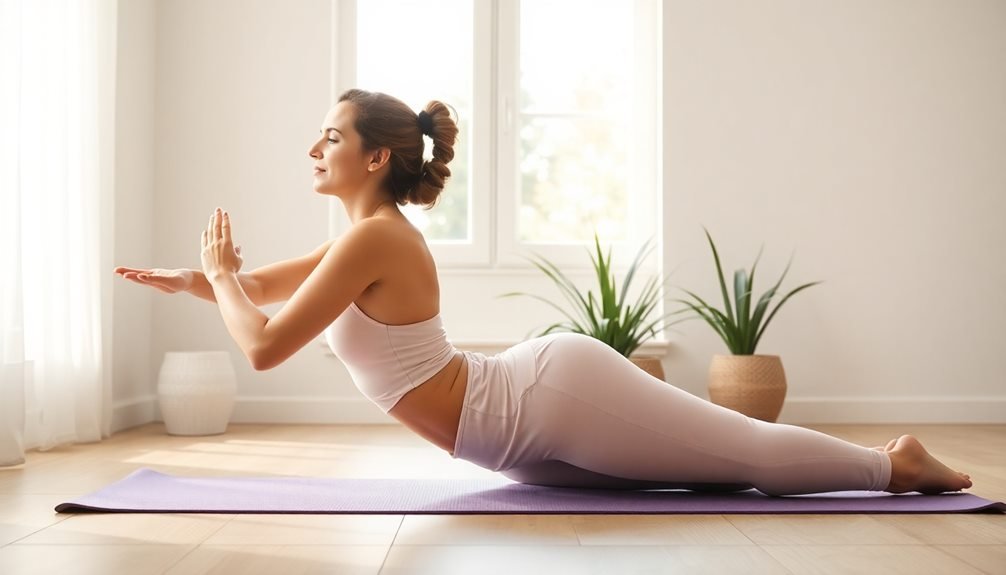
Leave a Reply